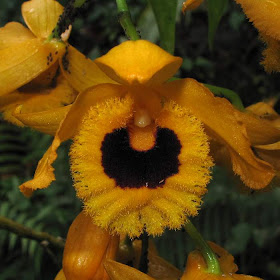I have grown Dendrobium orchids for many years and it is one of my favorite orchid genera. Of the Dendrobium, the ones I like best are the fragrant species and hybrids. In the following article I will share details on the species and varieties I have grown, on their fragrances and on the particular quirks that the various species have exhibited under my culture. Many years ago, in a book whose title I can’t remember, I read about a circular garden that was divided in six parts. Each part of the garden was devoted to a different sense. The garden had five wedges, where all the wedges converged in the center there was another circle, this one devoted to the sixth sense, intuition, and planted with only with golden flowers. This garden captured my imagination, but unfortunately I could not make one. My work as a wildlife biologist has meant that I have lived either in urban areas near universities or deep in protected forests, in these places this type of garden was impossible. But in these settings orchids allowed me to enjoy delightful fragrances, lovely colors and interesting shapes without the need of large spaces, digging, or modifying the landscape in any significant way. Orchids had also the virtue of portability, when I moved, (something that has happened several times during my career), I just took them with me with little problem.
Of all the orchids I have, the Dendrobium represent the best combination of ease of culture, resistance to pests and consistent flowering. This didn’t happen by chance, I did my homework and tried to acquire those species that were best suited for my climatic conditions. Getting the information on the cultural needs of the particular Dendrobium you want to grow is very important as some species need a certain degree of seasonal variation of temperature and moisture to stimulate the buds in the cane to change from the vegetative to flowering mode. Pest resistance is important to me as I don’t want to have to continually use pesticides just to keep my plants in good condition. I do use pesticides but on spot applications and not as preventive measures. In respect to consistent flowering, taking care to give the plants the proper culture they need goes a long way toward achieving regular flowering even on plants that are sometimes labeled as difficult. I suspect that some of the difficulties faced by growers getting their plants to bloom may have to do with growers trying to grow them under conditions that are not really suited to that particular species.
I grow my orchids outside, in a terrace and in a shade house. I live near the central mountain range of Puerto Rico at an altitude of 1000 feet (350 mts), near the center of the Rio Abajo State Forest, where I work. The local temperatures range from 60F (16C) at night at the peak of winter to 90F at daytime in the height of summer, daily temperature variation is about 10 to 15 degrees. There are just two seasons, a dry and a wet one. Humidity fluctuates most of the year between 70 and 80% but varies from 40% during the day at the peak of the dry season to close to 100% at night during the rainy season. The plants are watered weekly during if it doesn’t rain. The plants are regularly watered during the dry season with the exception of those that need a seasonal dry spell. The plants receive fertilizer only when they are growing. Some effort was made to find the optimal sun exposure for each species. It was found that most bloom much better with several hours of exposure to full sunlight in the morning.
 |
| Dendrobium anosmum alba, small flowered, small lipped clone |
 |
| Dendrobium anosmun var. huttoni |
 |
| The most common type of Den. anosmum is also the most floriferous, it is capable of producing more than sixty flowers on a single cane |
 |
| Den. anomum variety from Thailand, the flower is suspiciously similar to Den. Nestor but the canes are unique and not similar at all to those of Nestor |
 |
| A Den. Nestor that favors the parishii parent |
 |
| A Den. Nestor that is quite distinct from most other forms hybrid |
 |
| A very small lipped form of Den. Nestor with very thick textured flowers |
 |
| In the front, Den. farmeri var. albiflorum, an outstading clone of this type, in the background a typically colored form. The fragrance is faint but clearly felt when there are many flowers |
 |
| A flower of Den. farmeri albiflorum |
 |
| Den. farmeri, a faint fragrance |
 |
| Dendrobium harveyanum, formerly an extremerly difficult to find species, a slight honey fragrance |
 |
| Den. crumenatum, powerfully fragrant at certain times of the day |
 |
| Den. parishii, delightfully frangrant with a sweet note |
 |
| Den. chrysotoxum, a sweet slight honey fragrance |
 |
| Den. fimbriatum var. oculatum, a sour citrical fragrance |
 |
| Den. nobile, a slight sweet fragrance |
 |
| Dendrobium moschatum it has complex fragrance delightful to some, unpleasant to others |
 |
| Dendrobium spectabile it has a complex fragrance sweet to some, to others like crushed stinkbugs |


This comment has been removed by the author.
ReplyDeleteHi there, I was wondering how come your den farmeri has so dense and vivid colors. The one I have has very pale pink colour and lose flower. It is a large time. Any growing tips ?
ReplyDeleteI recently purchased a small, yet to flower plant of Dendrobium Supernestor 'Pinnacle'. I have grown lots of Phalinopsis but no Dendrobium. Do you have suggestions as to care of my new plant?
ReplyDeleteThank you,
Diana
Beautiful flowers, I loved it
ReplyDelete